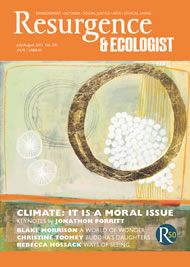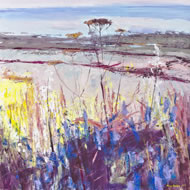As an adult, Peter Owen Jones started walking seriously every day after having Bell’s palsy and recovering from an “exhausted twilight”. It brought him back to life. His passion for discovering the natural world had started at a young age, when he was encouraged by his mother to roam on his own in the valleys around their home. He remembers his reaction as a boy to the view of open landscape from an abandoned barn: “It called me, called me into the distance, into the unknown.” This collection of circular walks is a response to that same call, “to find sweetness again”.
Pathlands is no ordinary walking book. The author does not follow a prescribed route, nose pressed to the map and only the destination in mind. He takes pleasure in being in a place without having to know where he is: “It becomes almost a meditation, a relinquishing of all thought – the tight wires of worries, the vanity of plans, these evaporate, leaving only the purity of what is seen and heard in the present moment.”
Walking is not, as he writes, just about “going from here to there”. It is a journey of discovery, encounters with the unexpected, communion with Nature and becoming present. On that journey we discover both the world around us and our internal landscape: “When we walk, we walk through two landscapes: an exterior land of trees, seas, cities, mountains and fields and along the paths that lead into our own interior world.” The more time we spend on those paths, the more we find solace, stillness, healing, renewal and freedom. We return to ourselves, to the self “born fluent in feeling”. He writes in the preface, “As St Francis of Assisi said, ‘Solvitur ambulando’ – it can be solved by walking.”
Owen Jones takes us to uplands, lowlands, coast, rivers, fields, meadows and woodlands throughout England, out to the Channel Islands, up to the Scottish borders and into Wales. Avoiding the well-trodden routes, he has made a delightful selection of what he calls “everyday paths” between villages, paths that form “the bedrock of the sense of freedom in this land”. We follow him through every season: in the “brittle electric light” of November in Ceredigion; the “heady mixture of milk and sugar” of spring in Norfolk; the vivid quality of midsummer light in Cornwall; April in West Sussex, the air infused with “one of the most illicit scents of spring. Sweet and raunchy, somewhere between seaweed and honey, the heady drift of St George’s mushrooms”; and in December on the Staffordshire-Derbyshire border, exploring a land “soaked in greys”, where he concludes, in spite of its apparent unrelenting hostility, “The great gift of winter is the gift of rest.”
His excursions through different seasons are a celebration of the richness and diversity of the wildlife he encounters. Whilst celebratory and beautifully descriptive, his accounts are neither overly romantic nor sentimental. The wild, exuberant variety of hedgerows and the lovingly well-tended vegetable gardens and allotments he comes across are juxtaposed with the “mausoleum of monoculture”, and evidence, both historical and contemporary, of the human commodification of and impact on the landscape: the mineshafts on Clee Hill in Shropshire; the nuclear power station at Dungeness, and the dark silence of conifer plantations on the Scottish borders, trees “packed in as tightly as battery hens”.
Insightful, perceptive and peppered with the author’s warm sense of humour, Pathlands weaves together natural history, the history of human interaction with the landscape and folklore in a book to treasure. The only problem for the reader is whether you can sit still long enough to read it when its invocation to go out walking and “enter the state of wonder” is so powerful and inspiring.








